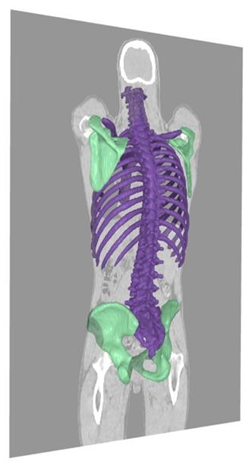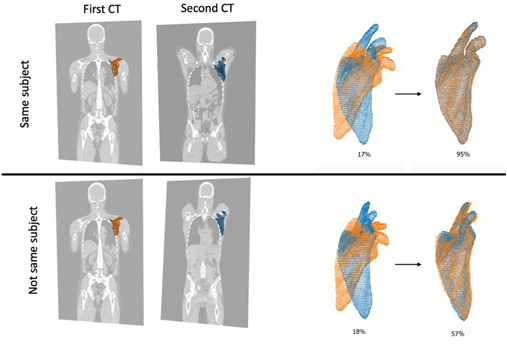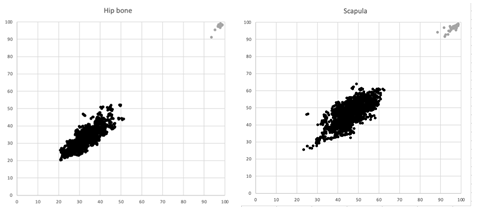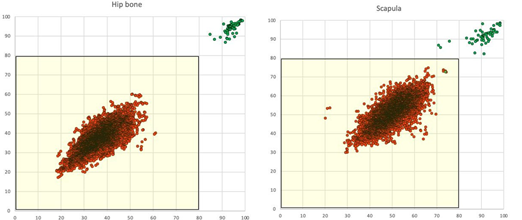Fingerprint: An AI-Based Method For Detection of Mislabeled CT Studies In Clinical Trials
Article Information
Lars Edenbrandt*1,2, Olof Enqvist3, Tony Gillberg1
1SliceVault AB. Malmö, Sweden.
2Department of Molecular and Clinical Medicine. Institute of Medicine, Sahlgrenska Academy, University of Gothenburg, Gothenburg. Sweden.
3Eigenvision AB. Malmö, Sweden
*Corresponding Author: Lars Edenbrandt, Department of Molecular and Clinical Medicine. Institute of Medicine, Sahlgrenska Academy, University of Gothenburg, Gothenburg. Sweden.
Received: 10 January 2023; Accepted: 19 January 2023; Published: 31 January 2023
Citation:
Lars Edenbrandt, Olof Enqvist, Tony Gillberg. Fingerprint: An AI-Based Method For Detection of Mislabeled CT Studies In Clinical Trials. Journal of Radiology and Clinical Imaging. 7 (2023): 12-15.
View / Download Pdf Share at FacebookAbstract
The manual step of replacing the identification number of each subject in clinical trials with the correct trial identification number is critical. Mislabeling studies may lead to excluding subjects or visits or to false study results. This article presents an automated AI-based method to detect if a pair of de-identified CT studies has been obtained from the same subject. Approach: An automated segmentation of bones in CT is performed using Organ Finder (SliceVault AB, Malmö, Sweden). Corresponding bones from the two images are aligned using Iterative closest point. The percentage of vertices in the smaller mesh with residuals below 1.5 mm is used as a measure of similarity, the anatomical match. If the anatomical match is less than 80% for the left and right hip bone and the left and right scapula, the two CT studies are classified as being obtained from different subjects. The Fingerprint method was tested on a group of 58 patients, who each had two CT studies obtained at different occasions. From the 116 CT studies 6,612 unique pairs of CT from different patients and 58 pairs from the same patient could be selected. Results: The Fingerprint method classified all 6,612 pairs of CT studies from different patients correctly (sensitivity 100%; 95% confidence interval 99-100%) and all 58 pairs of CT studies from the same patients correctly (specificity 100%; 95% confidence interval 94- 100%). Conclusion: This study shows how an AI-based method can be used to accurately detect if a pair of de-identified CT studies has been obtained from two different subjects.
Keywords
Artificial Intelligence; Diagnostic Imaging; Machine Learning; Quality Assessment.
Artificial Intelligence articles; Diagnostic Imaging articles; Machine Learning articles; Quality Assessment articles
Artificial Intelligence articles Artificial Intelligence Research articles Artificial Intelligence review articles Artificial Intelligence PubMed articles Artificial Intelligence PubMed Central articles Artificial Intelligence 2023 articles Artificial Intelligence 2024 articles Artificial Intelligence Scopus articles Artificial Intelligence impact factor journals Artificial Intelligence Scopus journals Artificial Intelligence PubMed journals Artificial Intelligence medical journals Artificial Intelligence free journals Artificial Intelligence best journals Artificial Intelligence top journals Artificial Intelligence free medical journals Artificial Intelligence famous journals Artificial Intelligence Google Scholar indexed journals Diagnostic Imaging articles Diagnostic Imaging Research articles Diagnostic Imaging review articles Diagnostic Imaging PubMed articles Diagnostic Imaging PubMed Central articles Diagnostic Imaging 2023 articles Diagnostic Imaging 2024 articles Diagnostic Imaging Scopus articles Diagnostic Imaging impact factor journals Diagnostic Imaging Scopus journals Diagnostic Imaging PubMed journals Diagnostic Imaging medical journals Diagnostic Imaging free journals Diagnostic Imaging best journals Diagnostic Imaging top journals Diagnostic Imaging free medical journals Diagnostic Imaging famous journals Diagnostic Imaging Google Scholar indexed journals Machine Learning articles Machine Learning Research articles Machine Learning review articles Machine Learning PubMed articles Machine Learning PubMed Central articles Machine Learning 2023 articles Machine Learning 2024 articles Machine Learning Scopus articles Machine Learning impact factor journals Machine Learning Scopus journals Machine Learning PubMed journals Machine Learning medical journals Machine Learning free journals Machine Learning best journals Machine Learning top journals Machine Learning free medical journals Machine Learning famous journals Machine Learning Google Scholar indexed journals Quality Assessment articles Quality Assessment Research articles Quality Assessment review articles Quality Assessment PubMed articles Quality Assessment PubMed Central articles Quality Assessment 2023 articles Quality Assessment 2024 articles Quality Assessment Scopus articles Quality Assessment impact factor journals Quality Assessment Scopus journals Quality Assessment PubMed journals Quality Assessment medical journals Quality Assessment free journals Quality Assessment best journals Quality Assessment top journals Quality Assessment free medical journals Quality Assessment famous journals Quality Assessment Google Scholar indexed journals Organ Finder articles Organ Finder Research articles Organ Finder review articles Organ Finder PubMed articles Organ Finder PubMed Central articles Organ Finder 2023 articles Organ Finder 2024 articles Organ Finder Scopus articles Organ Finder impact factor journals Organ Finder Scopus journals Organ Finder PubMed journals Organ Finder medical journals Organ Finder free journals Organ Finder best journals Organ Finder top journals Organ Finder free medical journals Organ Finder famous journals Organ Finder Google Scholar indexed journals †CT articles †CT Research articles †CT review articles †CT PubMed articles †CT PubMed Central articles †CT 2023 articles †CT 2024 articles †CT Scopus articles †CT impact factor journals †CT Scopus journals †CT PubMed journals †CT medical journals †CT free journals †CT best journals †CT top journals †CT free medical journals †CT famous journals †CT Google Scholar indexed journals PET/CT† articles PET/CT† Research articles PET/CT† review articles PET/CT† PubMed articles PET/CT† PubMed Central articles PET/CT† 2023 articles PET/CT† 2024 articles PET/CT† Scopus articles PET/CT† impact factor journals PET/CT† Scopus journals PET/CT† PubMed journals PET/CT† medical journals PET/CT† free journals PET/CT† best journals PET/CT† top journals PET/CT† free medical journals PET/CT† famous journals PET/CT† Google Scholar indexed journals Finger print articles Finger print Research articles Finger print review articles Finger print PubMed articles Finger print PubMed Central articles Finger print 2023 articles Finger print 2024 articles Finger print Scopus articles Finger print impact factor journals Finger print Scopus journals Finger print PubMed journals Finger print medical journals Finger print free journals Finger print best journals Finger print top journals Finger print free medical journals Finger print famous journals Finger print Google Scholar indexed journals Clinical Trial articles Clinical Trial Research articles Clinical Trial review articles Clinical Trial PubMed articles Clinical Trial PubMed Central articles Clinical Trial 2023 articles Clinical Trial 2024 articles Clinical Trial Scopus articles Clinical Trial impact factor journals Clinical Trial Scopus journals Clinical Trial PubMed journals Clinical Trial medical journals Clinical Trial free journals Clinical Trial best journals Clinical Trial top journals Clinical Trial free medical journals Clinical Trial famous journals Clinical Trial Google Scholar indexed journals convolutional neural network† articles convolutional neural network† Research articles convolutional neural network† review articles convolutional neural network† PubMed articles convolutional neural network† PubMed Central articles convolutional neural network† 2023 articles convolutional neural network† 2024 articles convolutional neural network† Scopus articles convolutional neural network† impact factor journals convolutional neural network† Scopus journals convolutional neural network† PubMed journals convolutional neural network† medical journals convolutional neural network† free journals convolutional neural network† best journals convolutional neural network† top journals convolutional neural network† free medical journals convolutional neural network† famous journals convolutional neural network† Google Scholar indexed journalsArticle Details
1. Introduction
In clinical trials, diagnostic images are commonly de-identified and uploaded to a central repository for further analysis. The manual step of replacing the identification number of each subject with the correct trial identification number is critical. Mislabeling studies may lead to excluding subjects or visits or to false study results. In some situations, detecting that two CTs are obtained from different subjects is easy by visual inspection, for example if the subjects differ in size, gender, or if one subject has a hip prosthesis, but it can easily be overlooked especially as mistakes are rare and the focus of the image reader is on other tasks such as tumor detection. Artificial intelligence (AI)-based methods are well suited to handle this issue, tirelessly looking for the unlikely mistake. This article presents an automated AI-based method to detect if a pair of de-identified CT studies has been obtained from the same subject or not.
2. Methods
Patients
A. Training Set
The Fingerprint method was developed using a group of lymphoma patients who had undergone more than one PET/CT examination for the purpose of treatment response evaluation. Only the CT images were used in this study. The training set consisted of 8 female and 19 male patients with a median age of 34 years (range 15 to 73 years).
PET/CT data were obtained using an integrated PET/CT scanner (Siemens Biograph 64 Truepoint). A low-dose CT scan (64-slice helical, 120 kV, 30 mAs, 512 × 512 matrix) was obtained covering the base of the skull to the mid-thigh. Slice thickness and spacing between slices were 3 mm.
There was a total of 63 studies from which 1,953 unique study pairs could be selected. Out of these, 46 pairs consisted of CT studies from the same patient obtained at different occasions and the remaining 1,907 pairs consisted of CT studies from different patients. Ethical approval was granted by the ethics committee at Gothenburg University (#295-08).
B. Test Set
The Fingerprint method was evaluated using a publicly available dataset of 58 female patients with a median age of 52 years (range 22 to 83 years) [1-2].
PET/CT data were obtained using integrated PET/CT scanners (Discovery LS, ST, and STE, GE Medical Systems, Gemini TF, Philips Medical Systems, Biograph 6, 40, 64 and Sensation 16 Siemens). A CT scan (120-140 kV, 42-398 mAs, 512 × 512 matrix) was obtained covering the base of the skull to the mid-thigh. Slice thickness and spacing between slices were 2-4.25 mm. There were two CT studies for each patient. From the 116 studies, 6,670 unique study pairs were selected. Out of these pairs, 58 consisted of CT studies from the same patient obtained at different occasions and the remaining 6,612 pairs consisted of CT studies from different patients.
C. The Fingerprint Method
The first step of the Fingerprint method is an automated organ segmentation. The AI-tool Organ Finder (SliceVault AB, Malmö, Sweden) is used to segment organs in the two CT studies to be compared [3]. Organ Finder is based on a convolutional neural network (CNN) trained on 1,151 CT studies with manual organ segmentations. This CNN segments 22 different organs and four of those, the left and right hip bone and the left and right scapula, are used in the Fingerprint method (Figure 1).

Figure 1: Bone segmentation from Organ Finder. The four green bones are used in the Fingerprint method.
The second step is to calculate an anatomical match measure describing the similarity between bones segmented from the two CT studies to be compared. SurfaceNets by Gibson is used to extract meshes describing the bone surfaces [4]. The meshes from the two studies are aligned using Iterative closest point (ICP) [5] to put them in a common coordinate system (Figure 2). For each vertex in the smaller mesh the closest distance to the other mesh is computed and the percentage of the vertices with residuals below a predefined threshold is used as a measure of similarity, the anatomical match.
Different thresholds were evaluated on the training set before selecting 1.5 mm. The anatomical match for each image pair in the training set, is shown in Figure 3. The separation between pairs of CT studies from the same and different patients was good both for hip bones and for scapulae.

Figure 2: Alignment of left scapula from two CT studies. The two studies above are from the same subject and the two studies below are from different subjects. The bones are aligned in 3D and the final anatomical match is 95% for the pair from the same subject and 57% for the pair from different
subjects.
The following criterion, based on the training set results, was implemented in the Fingerprint method. If the anatomical match is less than 80% for all four bones, the two CT studies are classified as being obtained from different subjects. This criterion correctly classified all pairs in the training set.

Figure 3: Anatomical match for the left (Y axis) and right (X axis) sided hip bone and scapula. Grey dots represent pairs of CT studies from the same subject (n=46) and black dots represent pairs of CT studies from different subjects (n=1,907)
D. Statistical Methods
The Clopper-Pearson (exact) method was used to calculate the 95% confidence intervals (CI) for a binomial probability.
3. Results
The Fingerprint method classified all 6,612 (sensitivity 100% CI 99-100%) pairs of CT studies from different subjects correctly and all 58 pairs of CT studies from the same subjects correctly (specificity 100% CI 94-100%). Figure 4 shows the data points separately for hip bone and scapula

Figure 4: Anatomical match for the left (Y axis) and right (X axis) sided hip bone and scapula, respectively. Green dots represent pairs of CT studies from the same subject (n=58) and red dots represent pairs of CT studies from different subjects (n=6,612).
4. Discussion
This study shows that mislabeled CT studies in clinical trials can be detected by comparing the shape of bone structures. The shape and size of a hip bone and scapula mimic the feature of a human fingerprint in being unique for every individual, but our CT-based Fingerprint method is not intended to identify individuals with high degree of certainty, but to alert clinical trial staff that a CT study may be mislabeled.
The Organ Finder tool was used to segment the hip bones and scapulae of the 63 CT studies. The segmentations showed to be very accurate. This is in agreement with the results from the paper describing Organ Finder in which the Sørensen-Dice index was
0.97 and 0.94 respectively for these to bones [3]. A good organ segmentation is essential for the Fingerprint method to be accurate.
The CT studies of the test set were obtained with scanners from different vendors. The protocols used also differed with for example slice thickness ranging from 2 to 4.25 mm. The good results despite this variation indicate that the Fingerprint method can be useful in clinical trials where this type of variation is common.
A limitation of the present study is the relatively small number of same-subject CT pairs. In the real application, this type of pairs will be much more common than pairs from different subjects, so it is crucial to keep the number of false alarms down. Our results indicate that our current thresholds would result in few false alarms, but that has to be evaluated on a larger material.
The training set included predominantly male patients and the test set only female patients. A more well-balanced training set would be preferrable before testing the method in a larger population.
Future work will also include adding more bones for analysis. At present the Organ Findercannot segment separate vertebrae, but when that is included the Fingerprint method can be updated.
Quality checks of images will become more and more important in clinical trials. Good image quality is vital for reliable results and routines to check images are essential. We have recently shown that it is feasible to use AI-based methods to automatically perform a quality assessment with a very high accuracy [6]. The AI-based method in that study checked CT studies, both regarding the parts of the body included (i.e., head, chest, abdomen, pelvis), and other image features (i.e., presence of hip prosthesis, intravenous contrast and oral contrast). The Fingerprint method developed in this study is another example of an AI method that can be of value in future clinical trials.
5. Conclusion
In conclusion, this study shows how the AI-based Fingerprint method can be used to accurately detect if pairs of de-identified CT studies have been obtained from different subjects.
6. References
- Clark KW, Vendt BA, Smith KE. “The cancer imaging archive (tcia): Maintaining and operating a public information J.Digital Imaging. 26 (2013): 1045–1057.
- Kostakoglu L, Duan F, Idowu MO, Jolles PR, Bear HD et al. A phase II study of 30 -Deoxy-30 -18F-fluorothymidine PET in the assessment of early response of breast cancer to neoadjuvant chemotherapy: results from ACRIN 6688. J Nucl Med 56 (2015): 1681–1689.
- Edenbrandt L, Enqvist O, Larsson M, Ulen J. Organ Finder – a new AI-based organ segmentation tool for CT. J Radiol Clinical Imaging 5 (2022): 65-70.
- Gibson, SF. Constrained elastic surface nets: Generating smooth surfaces from binary segmented data. In: International Conference on Medical Image Computing and Computer-Assisted Intervention. Springer, Berlin, Heidelberg, 1998: 888- 898
- Zampogiannis K, Fermuller C, Aloimonos Cilantro: A lean, versatile, and efficient library for point cloud data processing. Proceedings of the 26th ACM International Conference on Multimedia. 2018: 1364-1367.
- Edenbrandt L, Tragardh E, Ulen J. AI-based image quality assessment in Arch Clin Biomed Res. 6 (2022): 869-872
